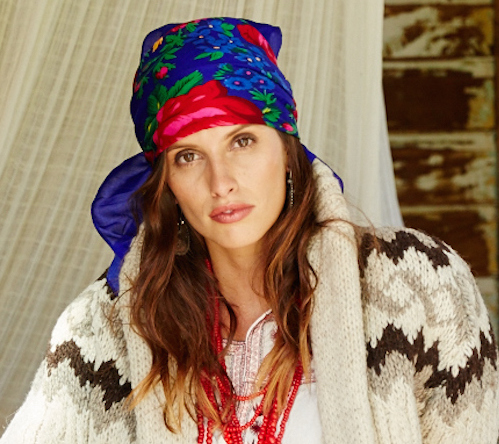Bohemian Elegance: Unraveling the Gypsy-Style Kerchief Fashion of the 1960s

Introduction:
The 1960s was a decade of cultural revolution and a profound shift in fashion aesthetics. Among the various style revolutions, the gypsy-style kerchief emerged as a symbol of free-spirited bohemianism. The kerchief, worn with an effortless charm, became a quintessential accessory that encapsulated the era’s rebellious spirit. In this detailed exploration, we delve into the history, cultural influence, styling techniques, and enduring legacy of the gypsy-style kerchief, uncovering how it became an integral part of the vibrant tapestry of 1960s fashion.
Chapter 1: Origins and Cultural Influences
1.1 Romanticizing the Gypsy Aesthetic:
The 1960s saw a fascination with the bohemian lifestyle, with influences from the Romani or Gypsy culture finding their way into fashion. The gypsy-style kerchief, often adorned with vibrant prints and colors, became a tangible expression of the desire for a more liberated and unconventional lifestyle.
1.2 Ethnic and Folklore Inspirations:
Fashion designers drew inspiration from ethnic and folklore elements, infusing their creations with a sense of wanderlust and nomadic charm. The gypsy-style kerchief, with its rich patterns and eclectic designs, captured the essence of this trend, contributing to the era’s broader cultural amalgamation.
Chapter 2: The Kerchief as a Symbol of Freedom
2.1 Anti-Establishment Fashion:
The 1960s was marked by a countercultural movement that rejected established norms. The gypsy-style kerchief, worn loosely and casually, symbolized a breakaway from the rigid and conservative fashion of the past, becoming a sartorial expression of anti-establishment sentiments.
2.2 Feminine Liberation:
Women embraced the gypsy-style kerchief as a symbol of feminine liberation. Its carefree and unstructured nature allowed for a sense of empowerment, reflecting the broader cultural shift towards women’s liberation and the rejection of restrictive fashion norms.
Chapter 3: Kerchief Styles and Variations
3.1 Headscarf Elegance:
The gypsy-style kerchief was predominantly worn as a headscarf, framing the face with a touch of mystery and allure. Tied in various styles – be it a loose and flowing drape or a more structured turban-like wrap – the kerchief added an air of bohemian elegance.
3.2 Neck and Wrist Accents:
Beyond the head, the gypsy-style kerchief found its way to necks and wrists as fashionable accessories. Worn as a loose necktie or wrapped around the wrist as a bracelet, these variations added a touch of casual chic to any ensemble.
Chapter 4: Fabrics, Colors, and Patterns
4.1 Lively Prints and Patterns:
The gypsy-style kerchief was characterized by its lively prints and patterns, often drawing inspiration from floral motifs, paisley designs, and ethnic symbols. The riot of colors and eclectic combinations reflected the era’s embrace of bold and unconventional fashion.
4.2 Lightweight Fabrics:
To enhance the carefree and flowing nature of the kerchief, lightweight fabrics such as silk, chiffon, and cotton were commonly used. These materials added to the comfort and versatility of the accessory, allowing it to be worn in various styles and weather conditions.
Chapter 5: Gypsy-Style Kerchief in Popular Culture
5.1 Cinematic and Celebrity Endorsements:
The gypsy-style kerchief found its way into popular culture through cinematic portrayals and celebrity endorsements. Actresses like Brigitte Bardot and Audrey Hepburn showcased the versatility of the kerchief, cementing its status as a glamorous yet accessible accessory.
5.2 Music Festival Fashion:
As the 1960s progressed, the gypsy-style kerchief became synonymous with the burgeoning music festival culture. Worn by bohemian free spirits at events like Woodstock, the kerchief evolved into a symbol of the counterculture movement and a celebration of communal harmony.
Chapter 6: Styling Techniques and Cultural Appropriation
6.1 Creative Tying Techniques:
Part of the charm of the gypsy-style kerchief lay in its versatility. Creative tying techniques, such as the classic bandana knot or the turban wrap, allowed individuals to personalize their style and experiment with different looks, further contributing to its popularity.
6.2 Cultural Appropriation Debate:
The widespread adoption of gypsy-style fashion raised concerns about cultural appropriation, as the trend often romanticized and commodified elements from Romani culture. The debate surrounding cultural sensitivity and appreciation became an integral part of discussions about fashion ethics.
Chapter 7: The Gypsy-Style Kerchief Today
7.1 Revival in Contemporary Fashion:
The gypsy-style kerchief has experienced periodic revivals in contemporary fashion. Designers and fashion enthusiasts continue to embrace its bohemian allure, incorporating modern interpretations into their wardrobes and runway collections.
7.2 Ethical and Sustainable Fashion:
The resurgence of interest in bohemian styles has led to a renewed focus on ethical and sustainable fashion practices. Designers are exploring eco-friendly materials and production methods, ensuring that the gypsy-style kerchief remains a symbol of free-spirited fashion with a conscious twist.
Chapter 8: Conclusion – A Timeless Symbol of Bohemian Chic
In conclusion, the gypsy-style kerchief of the 1960s remains a timeless symbol of bohemian chic and a testament to the era’s desire for freedom and self-expression. Worn with a carefree spirit and embraced by individuals seeking to break away from traditional fashion norms, the kerchief has left an enduring legacy that continues to captivate and inspire. Its journey from a countercultural accessory to a symbol of ethereal elegance showcases the transformative power of fashion, where a simple piece of fabric can transcend time, carrying with it the essence of an era defined by rebellion, individualism, and the pursuit of unbridled freedom. The gypsy-style kerchief, in all its vibrant patterns and flowing grace, remains a cherished relic of the Swinging Sixties, inviting us to celebrate the enduring allure of bohemian fashion.




